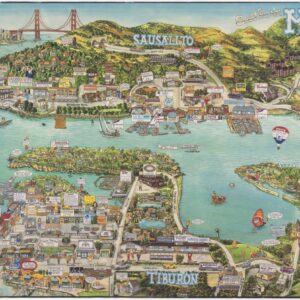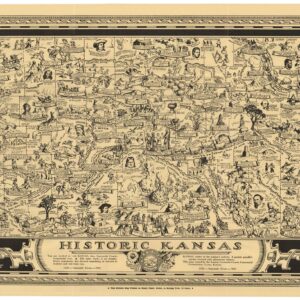The Ultimate Pictorial Map of California in the late 60s, here the highly sought-after and larger limited edition.
California [Deluxe edition screen-printed on linen]
Out of stock
Description
This rare and groovy cartoon map of California captured the imagination of young Americans everywhere and helped draw thousands to the Rock ‘n’ Roll hubs of Los Angeles and San Francisco. One would be hard pressed to finder a cooler depiction of California in the late 1960s than this.
Depicting the state disproportionately so that the cities of Los Angeles and San Francisco dominate the visual field, the poster was designed by artist and illustrator John F. Johnson (his signature is found in the lower right of the image) and published by David Schiller of Sparta Graphics in 1968. Schiller had worked with a range of musical superstars, including bands like The Beatles, The Monkees, Jefferson Airplane, and Buffalo Springfield. This particular poster was not made to promote any one band, but was rather a cool and humorous depiction of the state that had attracted so much attention during the ‘summer of love’ (1967). It was a means of conveying some of the glamour and beauty, but especially the free spirit that characterized the West Coast at that time. San Francisco in particular was famous as the hippie capital, and the map includes great little details like an assembly of flower children on a hill and a banner flying from a tree that reads ‘Haight Ashbury loves you.’
In order to promote California in this manner at this time, the map was designed to have the look of a rock ‘n’ roll or psychedelic album cover. At the same time, it had to highlight actual state attributes, such as the seashore or the progressive music scene. Consequently, we see a string of beaches, complete with bathing babes and surfers, depicted along the coast – One of them even carries a humorous label that reads ‘San Gregorio Nudist Beach: No Peeking.’
Just as fun are some of the many references to great bands of the day. In West Hollywood, for example, we are witness to a live performance by The Doors, while another famous LA band, Buffalo Springfield, are cruising across the fields of Napa in the same old steam roller that Sparta Graphics had designed for one of their most celebrated posters. Band references are even more pronounced in the Bay Area, with a large billboard in Oakland reading ‘Canned Heat’ and Quicksilver Messenger Service are jamming away outside San Quentin prison. The latter was one of the earliest psychedelic rock bands to be part of the San Francisco scene. Soaring over the Sierras towards the Bay Area is the famous Jefferson Airplane, which like the Buffalo steam roller also was designed by Schiller and Sparta Graphics. As the plane tracks over the mountains, fully loaded, it almost feels like an invitation to come along. The inclusion of this particular image was a standard feature in almost all of the posters issued by Sparta Graphics, but in this case it reverberated so positively that the poster came to be known as the ‘Jefferson Airplane map‘.

The map is not just pictorial but cartoonish to the extent that it borders on caricature, albeit a loving one. Certainly it bears little semblance to geographic reality. But it did perhaps visualize how many Americans – including Californians – perceived of the great West Coast state. Many of California’s great sights have been included in the compilation of this map, which also plays with space and proportion to make it all come together effectually. Perhaps not surprisingly, we find the famous cities of Los Angeles and San Francisco prominently depicted on the map. Yet even though LA and SF take up most of the available space, the map is far from being strictly urban. Many rural landmarks have also been depicted, including the dramatic peaks of the Sierra Nevada Mountains, Napa Valley, and California’s farm belt.
Because of the way that space is manipulated on the map, the two great cities almost seem to grow into one another. At the same time, they have almost been drawn as a form of juxtaposition. In the north and around San Francisco, sequoia dot the landscape, while in the south most of the much more sporadic trees are palms or similar arboreal exotica. There are other discrepancies as well. Los Angeles generally appears much more crowded and dirty, with smog alarms, dense traffic, and fast food joints all over the place. In contrast, San Francisco comes off as more homey, with smaller, more intimate buildings and spaces, rolling hills, and a cityscape connected by the romantic tramway. In the rural north, there are numerous hikers, fishermen, and other outdoorsy types, whereas the south is dominated by the highways east and the large naval base in San Diego.
Being a product of the age, the map is also explicitly political. We have noted how San Francisco and the hippie movement have been presented in a gracious light. In California’s capital, Sacramento, the atmosphere is altogether different. Reduced to little more than the capitol building itself, the town is full of signs sporting slogans like ‘Far Right Only’ or ‘Pave Vietnam’. The governor of California at this time, of course, was none other than Ronald Reagan.
Even though the smaller paper version of this poster was printed in significant numbers, this larger screen-print on linen was only produced in a limited edition, meant for larger public venues like record shops, concert halls, or bars. Our example of this rare poster map is not only beautifully preserved, but a marvelous keepsake from a bygone age.
Context is everything
During the late 1960’s, young people from all over America flocked to California as an expression of peaceful revolution against traditional hierarchies and values of their parents. Particularly abhorred was America’s celebration of consumerism and her militant engagements abroad. Especially San Francisco drew large crowds of young people form all over the country and, perhaps as a consequence of that, an experimental and highly progressive music scene developed here from 1965 onwards.
The movement was known as the hippie or flower-child movement, and consisted of a broad spectrum of disgruntled yet idealistic youths, intent on profound societal change. The movement lacked formal organization – or in fact one might say they shunned it – but it did address deep rifts in American society in a more direct fashion than had hitherto been the norm. This included issues like social inequality, racism, civil rights, and the global militarized fight against communism. The spirit of freedom and love did not just extend in the political sphere, but dominated the arts, music, and popular culture. New bands were constantly breaking the mould and challenging the very concept of what music was, often layering the experience with the effects of psychedelic drugs.
Even though the hippie movement focussed on San Francisco, within the city itself most of the hippies were centered around the intersection of Haight Street and Ashbury, just east of Golden Gate Park. In 1967, during what would come to be known as the Summer of Love, more than 100.000 people congregated in the neighborhood, quickly leading to huge social problems and a rise in violent crime. By the fall, things had settled down again and many of the hippies had left. A similar spirit gripped much of the United States in the following year, but those that had experienced San Francisco during the summer of love often define this as the apex of the movement.
References & Census
The OCLC notes a copy of the linen version of this poster at the University of Kansas (OCLC No. 964682880). A copy also figures in the collection of David Rumsey (list no. 11437.000).
Cartographer(s):
David Schiller was a California music promoter and printer who set up the infamous Sparta Graphics studio in 1966. Schiller and Sparta Graphics worked with many of the great bands of the age, but were especially dominant on the music scene in San Francisco. A large portion of the concerts posters, album covers, fliers, and other printed paraphernalia that were produced for the Sea Francisco music scene in the late sixties came from Sparta Graphics. The West Fillmore in particular was famous for its psychedelic posters, and most of these came from the offices of Sparta Graphics. Schiller would either hire in illustrators for specific jobs or rely on the skills of his partner, artist Jim Michaelson.
John F. JohnsonJohn F. Johnson was an illustrator based in Santa Cruz and working primarily on cartoons and graphic art. In 1967 he opened a small studio entitled Teapot Graphics, but his real claim to fame came from his work for Sparta Graphics and David Schiller. Under their employ, Johnson drew some of the most iconic posters of the age – including the famous Fillmore concert posters for Buffalo Springfield and The Jefferson Airplane.
Condition Description
Good. 3-color screen print on linen, backed on a board. Some fraying well away from image.
References
Rumsey 11437.000. OCLC 964682880.

![Inside [San Francisco]](https://neatlinemaps.com/wp-content/uploads/2019/11/NL-00737-scaled-300x300.jpg)

